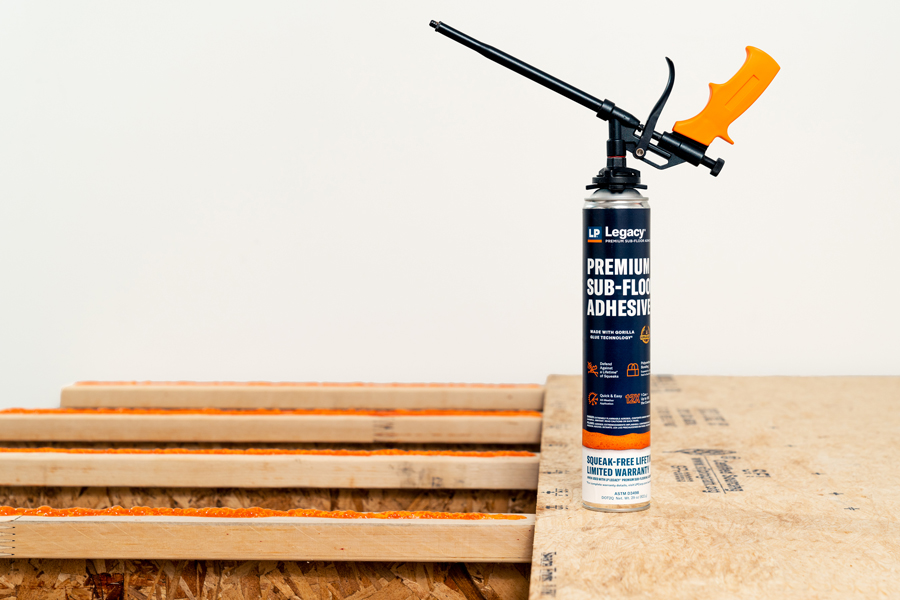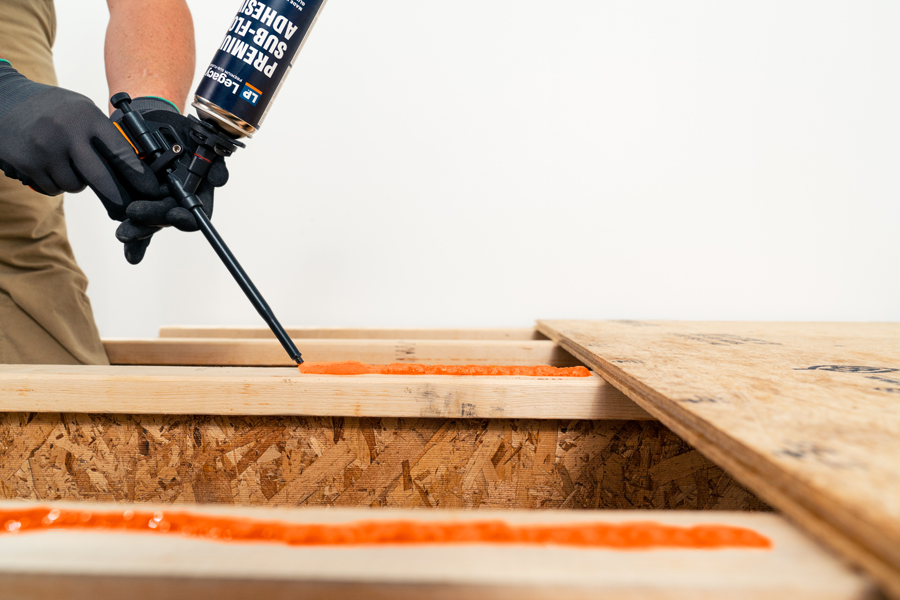Industry Trends5 min
A Guide to LP Legacy® Sub-Floor Adhesive
LP Legacy® Premium Sub-Flooring is known as one of the strongest OSB sub-floors on the planet and is a trusted product for builders looking for stiffer, stronger flooring solutions. But sub-flooring is just one part of a larger equation for overall floor stiffness. Recently, LP launched LP Legacy® Sub-Floor Adhesive to tackle creaks and squeaks head on.
What is Sub-Floor Adhesive?
Whether you're building a single-family home or a multi-floor complex, sub-flooring is a key factor of a sturdy and resilient structure. It's the building surface that homeowners will interact with the most-but it shouldn't be the one they notice. If sub-floors are doing their job, they won't cross the homeowner's mind at all. Using quality sub-floor adhesives can make all the difference.
Sub-floor adhesive is commonly used, in addition to fasteners, to secure sub-floor panels to floor supports. The adhesive can fill gaps between the panels and supports, which helps create a more stable floor system than nailing alone. But not all sub-floor adhesives are equal.
LP Legacy Premium Sub-Floor Adhesive doesn't just fill gaps; it can increase overall floor stiffness when correctly used with LP Legacy Premium Sub-Flooring and LP TopNotch 350 Durable Sub-Flooring. When used in LP sub-floor assemblies, the products carry a Squeak-Free Lifetime Limited Warranty against squeaks caused by the sub-floor fasteners rubbing within the sub-floor panels.

Sub-Floor Adhesive vs. Construction Adhesive
Construction adhesives are adhesives used on the jobsite to bond a variety of materials such as wood, metal and drywall. Sub-floor adhesive is a type of construction adhesive created specifically to bond sub-flooring to the floor supports. LP Legacy Sub-Floor Adhesive is designed to bond aggressively to wood, OSB, plywood and other substrates.
How Much Sub-Floor Adhesive Do You Need for Your Build?
LP Legacy Adhesive is a gun-applied, fast-curing, 100 % solvent-free polyurethane-based collapsible foam adhesive. One 29-ounce can is equal to up to 12 times the coverage of a typical tube of conventional sub-flooring adhesive. The amount of sub-floor adhesive you need will vary based on your build. Refer to the LP Legacy Sub-Floor Adhesive product literature for further instructions.
How Do You Apply Sub-Floor Adhesive?
Installation Prep - Prior to using the product, cover all adjacent areas for protection against soiling and put on protective goggles and gloves. Ensure the support surface is free of standing water or contaminants such as grease or oil. Screw the can tightly to the thread in the gun and shake the gun about 30 seconds with the valve pointing downwards. With the control knob on the gun, adjust the adhesive bead to the required diameter of about half an inch. The emptier the can, the more the control knob needs to be opened. Now you're ready for application.
First, apply the adhesive in uniform beads of 1/2-inch centrally onto the mounting structural supports. A distance of 3/8-inch to 3/4-inch must be maintained between the gun nozzle and substrate while spraying.

Next, place the sub-floor decking onto the adhesive no more than 20 minutes after dispensing. Do not remove and reapply panels as this will damage the adhesive structure and reduce the adhesive strength substantially.
Once the panels are set, and while keeping pressure, secure the boards additionally with mechanical fasteners. Be sure to refer to the complete installation instructions as you install.
As a complement to LP Legacy Adhesive, LP also offers LP Legacy Polyurethane Foam Cleaner, a supporting solution designed to clean the applicator and prevent clogging. Explore all that LP has to offer when it comes to sub-flooring accessories here.
Continue Reading
Resiliency Solutions
5 minIntroducing LP® SmartSide® ExpertFinish® Naturals Collection™: Nature-Inspired Beauty Meets Engineered Performance
We're excited to introduce the LP® SmartSide® ExpertFinish® Naturals Collection™, a bold new addition to our trusted line of engineered wood siding and trim that delivers the warmth and beauty of nature with the advanced protection and performance builders and homeowners expect.
Labor Solutions
5 minChoosing the Right LP® Structural Solutions Product for Your Build
When it comes to building strong, reliable, and high-performing structures, the materials you choose matter. At LP Building Solutions, we understand that every project, whether it's a single-family home or a multifamily development, requires structural components that meet your needs for strength, durability, and efficiency.
Sustainability Solutions
5 minBuilding a More Sustainable Future with LP Building Solutions
In today's world, sustainability is no longer just a buzzword, it's a blueprint for responsible living and smarter building. As the construction industry seeks ways to reduce its environmental footprint, LP Building Solutions is focused on providing innovative building materials for eco-conscious builders to help reshape what it means to build sustainably
News & Stories3 min
History of Partnership with Gary Sinise Foundation
The LP Foundation is a proud partner of the Gary Sinise Foundation, which supports wounded veterans in several ways. You can learn more about the LP Foundation here.